How to install a do-it-yourself washing machine in the kitchen
 There is an opinion that a washing machine, located in the kitchen area, will certainly “spoil” the general appearance of the room, will bring some kind of untidiness into it. In fact, placing a washing machine in the kitchen can be a great and even ideal way of planning. With a competent approach to the process, the machine will only complement the interior, making it more functional. How to install a washing machine in the kitchen, what nuances to consider and what to focus on, we will describe in this article.
There is an opinion that a washing machine, located in the kitchen area, will certainly “spoil” the general appearance of the room, will bring some kind of untidiness into it. In fact, placing a washing machine in the kitchen can be a great and even ideal way of planning. With a competent approach to the process, the machine will only complement the interior, making it more functional. How to install a washing machine in the kitchen, what nuances to consider and what to focus on, we will describe in this article.
Procedure
Before you buy a machine, you should plan in which place to place it, think about whether it will be built into the kitchen furniture or installed permanently. Focusing on these parameters, it is necessary to select the AGR of suitable dimensions. The ideal option is to think over all the details at the stage of repairing the room.
First you need to determine where the unit will be delivered. It is best that the equipment is located close to utilities, this will allow you to seamlessly organize points of connection to the water supply and sewage.
It is equally important to bring a separate electrical point protected by the machine under the automatic machine. The socket must comply with all safety regulations. Another serious aspect is the strengthening of the flooring at the place of installation of the washer. The floor under the body must be strong and even, this will ensure the stability of the washing machine during operation. If we describe the front of the upcoming work in general terms, it will consist of the following stages:
- preparation of the washer after transportation;
- installation of the unit at a selected location and placement of the housing;
- creating an electrical point for the device;
- connecting the water intake hose to the water supply network;
- connecting the drain of the machine into the sewer pipe.
In the case when the automatic machine is built-in, the algorithm of actions will be supplemented by hanging the facade on the cabinet of the kitchen unit. When embedding appliances in furniture, it is necessary to carefully choose a washing machine, the dimensions of the machine should ideally match the dimensions of the cabinet. The main plan of action is defined, you can proceed to a detailed description of the upcoming work.
Floor under the typewriter
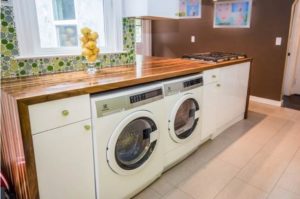 It’s easy to connect a washer in the kitchen area with your own hands, the main thing is to adhere to the main recommendations for action. Be sure to consider the type of flooring in your kitchen. Experts do not recommend putting the car on a laminate or parquet board - if even a small leak occurs, the coating may swell and become unusable. If you are sure that the housing is 100% protected from accidental leaks, do not forget that the dust filter will have to be cleaned periodically, and when you open the cork, the liquid will still fall onto the floor.
It’s easy to connect a washer in the kitchen area with your own hands, the main thing is to adhere to the main recommendations for action. Be sure to consider the type of flooring in your kitchen. Experts do not recommend putting the car on a laminate or parquet board - if even a small leak occurs, the coating may swell and become unusable. If you are sure that the housing is 100% protected from accidental leaks, do not forget that the dust filter will have to be cleaned periodically, and when you open the cork, the liquid will still fall onto the floor.
The ideal coating under the machine is tile or concrete. The surface must be not only waterproof, but also very durable, since during operation the washing machine has the ability to vibrate, swing and “jump”.
Cooking electrical network
A little more complicated can be the process of organizing an electrical point under the machine with your own hands. Due to the fact that the washer is distinguished by a rather high power consumption, it will have to output a separate electric line from the panel device. The connection diagram will be transparent: the contact from the input is transferred to the circuit breaker, from it it is fed to the residual current circuit breaker, after which the phase goes by wire to the outlet outlet.
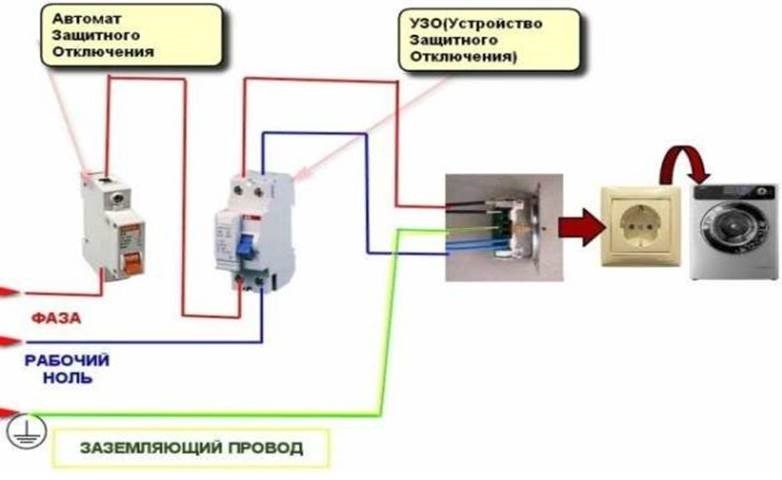
The electric point for the washing machine must be grounded; in its absence, the factory guarantees for the unit are not saved.
It is important to correctly calculate the rating of the protective circuit breaker.The machine is selected based on the current value required by the washer. The value can be spied in the technical passport or determined independently. For example, if the machine’s power is 3.5 kW, it is necessary to divide this value by 220 V. In the course of a simple calculation, we get a current equal to 15.9 Amps. The protective circuit breakers presented for sale have standard ratings: 6, 10, 16, 20 Amperes. For the described example, a 16 A protection device would be ideal.
When choosing an RCD, it should be taken into account that its face value should be one step higher than the similar characteristic of the machine. In our case, the rating of the device should be 32 A. Pay attention to the leakage current of the RCD. When connecting the device to a dedicated line, the value of this parameter should be 10 mA.
It is also important to choose the wires of the desired cross section. So, for washing automatic machines with a power of less than 4.1 kW, cables with a cross-section of 1.5 sq. Mm are perfect, for machines with a power consumption of up to 5.5 kW - the cross-section of the core should be 2.5 sq. Mm. In work, it is advisable to use wires with copper conductors.
And, of course, you need to choose the right outlet. When choosing, focus on the presence of a grounding device, the maximum voltage value, the rated operating current. This information can be obtained by studying the markings on the housing of the outlet. When the manufacturer has not indicated the necessary data on the device, it is better to refuse to purchase the device, it may be performed poorly and will not be able to properly perform its functions.
Preparing the machine for installation
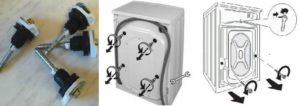 What needs to be done after the machine is bought and delivered to your home? Of course, free the unit from packaging, remove the protective elements located on the surface of the housing. Remember to remove the transport bolts. This is a very important rule, since, having forgotten to pull them out of the case, you can spoil the machine already at the first use.
What needs to be done after the machine is bought and delivered to your home? Of course, free the unit from packaging, remove the protective elements located on the surface of the housing. Remember to remove the transport bolts. This is a very important rule, since, having forgotten to pull them out of the case, you can spoil the machine already at the first use.
The screws designed to hold the drum during transportation of the device are loosened out with an ordinary wrench, which comes complete with washing equipment. After the bolts and bushings are removed from the case, it is necessary to close the holes formed with special plugs supplied with the machine. After preparatory steps, you can connect the machine in the kitchen.
Connect the inlet hose
Usually, following the installation rules, the machine is connected to cold water. The heater, which is equipped with an automatic machine, heats the water received by the system to the desired temperature, depending on the selected washing mode. Some users, trying to reduce energy consumption, connect the machine to the hot water system. However, such savings are very doubtful: the tariffs for cold and hot water differ too much, so it will still be cheaper to pay for the kilowatts spent than for the “hot” cubes.
In addition, the intake of water from the hot water pipes into the tank will have a negative impact on the quality of washing. Proteins quickly curl from high temperatures, so it will be very difficult to remove them.
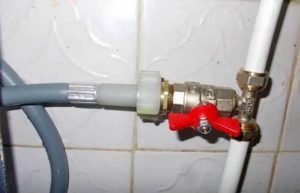 We proceed to the description of the installation process of the inlet hose. It comes with a washing machine, has a length of about 80 centimeters. If this length is not enough to connect the unit to the water supply, a hose length of 1 and 3 meters can be purchased at specialized retail outlets.
We proceed to the description of the installation process of the inlet hose. It comes with a washing machine, has a length of about 80 centimeters. If this length is not enough to connect the unit to the water supply, a hose length of 1 and 3 meters can be purchased at specialized retail outlets.
A special hole is provided on the back of the machine body, which has a rubber band, into which it is necessary to screw in a water intake hose. The union nut can be tightened by hand. If you use a key, do not turn it hard, just tighten the nut half a turn.
The other end of the inlet hose is included in the water supply system. In the case when a special conclusion is provided - well, if it is absent - you will have to make a tap of the tap. If in the kitchen the wiring is made of plastic or propylene pipes, you should purchase a special tee, cut off the water, carefully cut off part of the tube and solder the device. If there is a metal wiring, a welding machine will have to be used to insert the tee.
After the tee is installed, a crane should be attached to it. When attaching it, the thread should be wrapped with a special thread. If the water entering the apartment is characterized by high stiffness or severe pollution, before you turn on the tap, you can install a special filter. Such a measure is not mandatory, but is purely advisory in nature.
We organize the connection to the drain
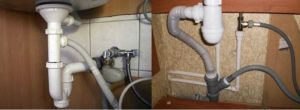 The drain hose supplied with the washing machine is connected to the sewage system. If the installation of the washing machine is carried out in close proximity to the kitchen sink, then there should not be any problems with the connection.
The drain hose supplied with the washing machine is connected to the sewage system. If the installation of the washing machine is carried out in close proximity to the kitchen sink, then there should not be any problems with the connection.
To do this, instead of the existing siphon, you need to purchase a new one with a special outlet for connecting the SMA or other household appliances. After installing a special siphon, it remains only to attach a drain hose to the branch. Another method is to plug the washer directly into the sewer system. To do this, you must:
- replace or insert a new tee going to the sink;
- organize a separate challenge for the AGR.
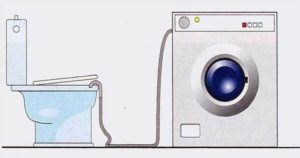 It is worth mentioning that the diameter of the drain hose is smaller than the size of the outlet point. Therefore, when installing, it is necessary to insert a rubber sealant into the tap. Such a measure will allow you to avoid leakage of the connection and the penetration of unpleasant odors into the apartment. The cuff is simply inserted into the output, the hose is stuck in an elastic band, which tightly compresses it, thereby ensuring water and air tightness of the system.
It is worth mentioning that the diameter of the drain hose is smaller than the size of the outlet point. Therefore, when installing, it is necessary to insert a rubber sealant into the tap. Such a measure will allow you to avoid leakage of the connection and the penetration of unpleasant odors into the apartment. The cuff is simply inserted into the output, the hose is stuck in an elastic band, which tightly compresses it, thereby ensuring water and air tightness of the system.
There are temporary ways to connect the drain hose. You can just drop the end of it into the kitchen sink with each wash. This method is undoubtedly the fastest, but this is where its merits end. And the disadvantages of this method are much greater - the unreliability of the design increases the risk of flushing water directly to the floor, in addition, the waste water will very quickly contaminate the sink.
With any method of connecting the washing machine to the sewer, be sure to ensure that the hose does not have kinks and does not fit loops.
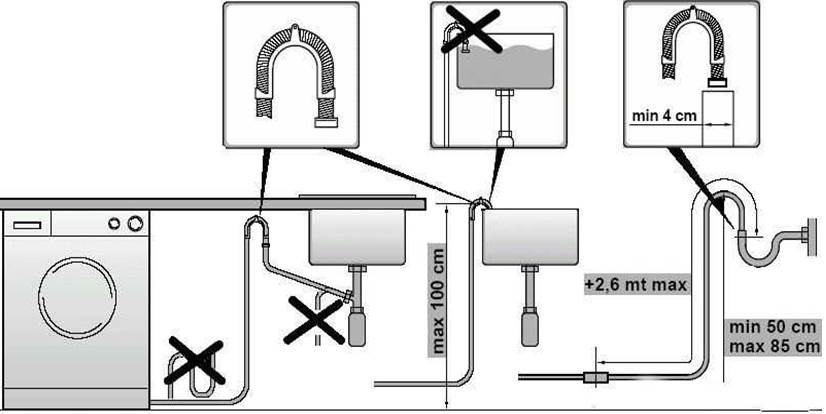
The bending radius of the drain pipe should be minimal, this will reduce the likelihood of clogging in its cavity. According to the installation rules, the bending radius of the corrugated hose must not exceed 85 cm. For reliable fixing of the hose in its original position, you can use special clamps that are mounted on the corrugation.
Interesting:
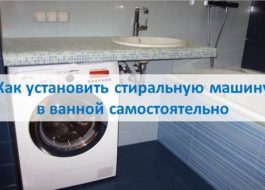 How to install a washing machine in the bathroom yourself
How to install a washing machine in the bathroom yourself How to install and connect a Samsung washing machine
How to install and connect a Samsung washing machine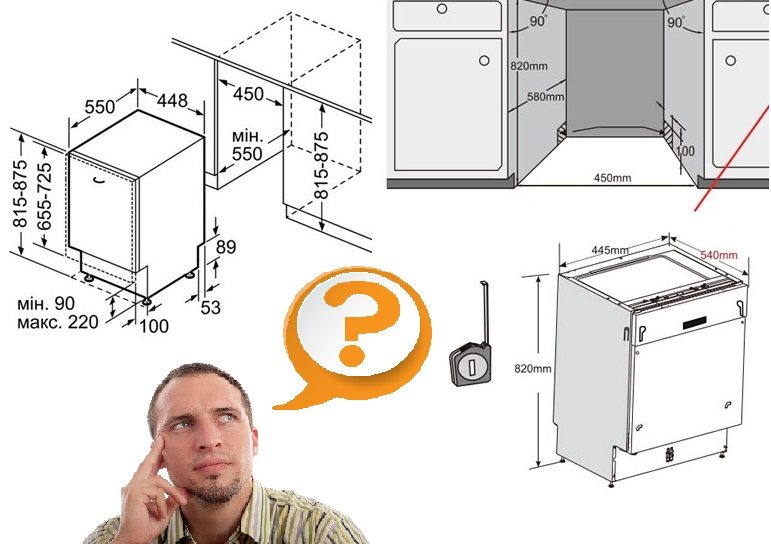 Installation of the built-in dishwasher
Installation of the built-in dishwasher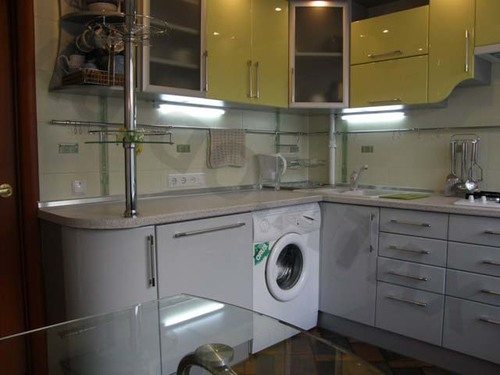 Washing machine in the kitchen under the countertop
Washing machine in the kitchen under the countertop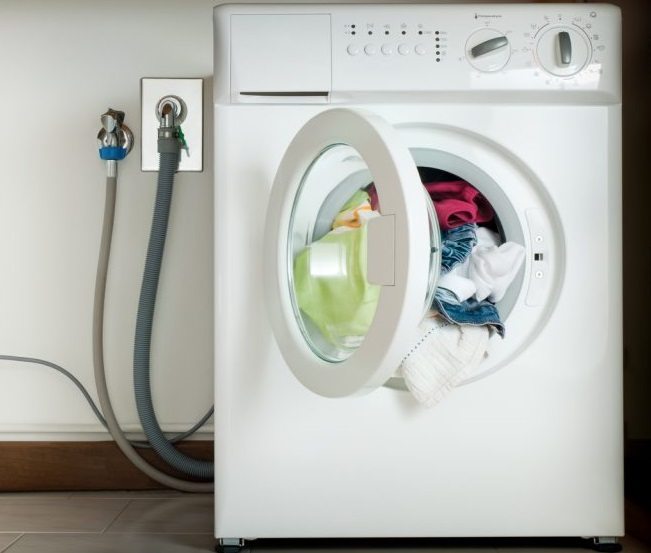 How to connect the drain hose of the washing machine to ...
How to connect the drain hose of the washing machine to ...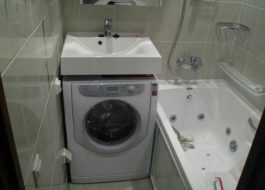 Where to put the washing machine in a small bathroom
Where to put the washing machine in a small bathroom
Reader Comments
- Share your opinion - leave a comment
Headings
Washing machine repair


For buyers
For users

Dishwasher












Add a comment